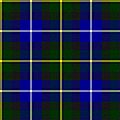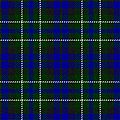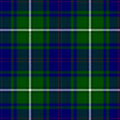Clan MacNeil facts for kids
Quick facts for kids Clan MacNeil |
|||
|---|---|---|---|
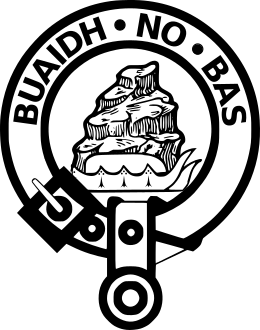 |
|||
| Motto | Buaidh no bas (Victory or death) also translated as "Conquer or Die" | ||
| Profile | |||
| Region | Highland and Islands | ||
| District | Western Isles | ||
| Plant badge | Dryas | ||
| Chief | |||
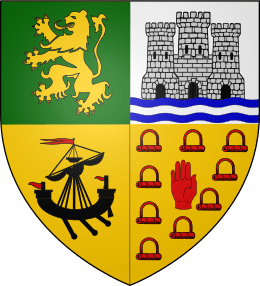 |
|||
| Roderick Wilson Macneil of Barra | |||
| The Macneil of Barra, Chief of Clan Niall and 27th of Barra, Baron of Barra | |||
| Historic seat | Kisimul Castle | ||
|
|||
|
|||
Clan MacNeil, also known as Clan Niall, is a famous Highland Scottish clan. It has roots in Ireland. Many believe the clan comes from a legendary Irish King named Niall of the Nine Hostages. The clan is especially linked to the island of Barra in the Outer Hebrides. The MacNeils get their name from a Niall who lived a long time ago, around the 1200s or early 1300s. This Niall was part of the same family as the ancestors of other clans like the Lamonts and Maclachlans. Even though the main part of the clan is on Barra, there is another group in Argyll (the McNeill/MacNeill family). Today, the chief of Clan MacNeil is recognized as the leader of all MacNeil(l)s.
Contents
History of Clan MacNeil
Where the Clan Began
The MacNeils of Barra
The MacNeils of Barra believe they are related to a prince from an old Irish royal family, the Uí Néill dynasty. This prince, Ánrothán Ua Néill, moved to Scotland in the 1000s. Through him, the Barra MacNeils also claim to be descendants of the famous Niall of the Nine Hostages. This same prince is also thought to be the ancestor of other Scottish clans like the Clan Lamont and Clan Maclachlan.
The first official record of the MacNeils of Barra is from 1427. At that time, a chief named Gilleonan Mac Néill received a special document for the lands of Barra and Boisdale. This happened after the previous lords of the area lost their lands.
Gilleonan's descendant, the twelfth chief, was one of the island leaders who were tricked by James V of Scotland. They were promised safety but were arrested and put in prison. The MacNeil chief was not set free until the king died in 1542. Later, in 1545, his son joined other chiefs in supporting Henry VIII of England. They signed a treaty that showed their old disagreements with the Scottish kingdom.
In 1579, the MacNeil chief of Barra faced a complaint about an attack. His son, the next chief, was often called a rebel by the government. He was known as the Turbulent or Ruari the Tatar. Some even called him the last of the Viking raiders because he often raided from his Kisimul Castle. The king eventually arranged for the chief's own nephews to capture him and put him in chains.
During the Scottish Civil War in the 1600s, the chief, Neil Og, was made a Colonel by Charles II of England. He fought in the Battle of Worcester in 1651. His grandson, Roderick Dhu the Black, received a special document that made all the lands of Barra a free barony. Roderick also led his clan at the Battle of Killiecrankie in 1689. He supported the Jacobite rising of 1715, which led to his two sons, Roderick and James, going to France. When their father died, they came back. But because of his support for the Jacobites, Roderick was put on a prison ship and taken to London. He was not released until 1747.
The clan did well for a while, but the twenty-first chief, General Roderick Macneil, had to sell Barra in 1838.
The McNeills of Argyll
The story of the Argyll MacNeills is also a bit unclear. In the late 1400s, a MacNeill was known as the keeper of Castle Sween. In the mid-1500s, a man named Torquil MacNeill was called the "chief and principal" of the MacNeils. Some historians believe Torquil was the last hereditary keeper of the castle.
At this time, there were separate MacNeil clans on Barra and Gigha. In 1553, the chief of the Gigha MacNeills sold the island. As the power of the Clan Campbell grew, the influence of the Gigha MacNeills lessened. Meanwhile, the MacNeils on the more distant island of Barra became more important. For a long time since, they have been seen as the main chiefs of the clan.
There was also a branch of the MacNeils who owned Colonsay island from 1700 to 1904. Some people think this branch might have been more important historically than the current Barra chiefs. However, in 1962, a special ruling stated that the chiefs of MacNeil of Barra are the chiefs of all MacNeil(l)s.
The Clan MacNeil Today
The 1700s and 1800s were very hard for the MacNeil clan members. Many people from Barra had to leave their homes and move to Canada, Australia, New Zealand, and the United States. This was called "mass clearance." In 1838, the chief, Lieutenant General Roderick MacNeil, had to sell Barra because he ran out of money.
In 1915, an American architect named Robert Lister MacNeil became the chief. In 1937, he was able to buy Barra and the old Kisimul Castle back, mostly with money from his second wife. He immediately started working to fix up the castle. By the time he died in 1970, the castle was restored. In 2001, the castle was leased to Historic Scotland for a thousand years for a very small rent. In 2004, the chief gave almost all of his land on Barra to the Scottish government.
The current chief of Clan MacNeil is Roderick Wilson MacNeil of Barra. He is the 27th chief of Barra. Even though he is an American citizen, he lives in Edinburgh, Scotland.
Clan Symbols
Crest Badges
Clan members can wear a crest badge to show they belong to the clan. This badge usually has the chief's heraldic crest and heraldic motto. The crest for Clan MacNeil shows a rock on a red velvet cap with ermine fur. The motto is buaidh no bas, which means "victory or death" in Scottish Gaelic.
The MacNeil(l)s who are part of the Colonsay group use a different crest badge. It shows an armored arm holding a dagger. Their motto is vincere aut mori, which means "conquer or die" in Latin.
Clan Badge
Another symbol is the clan badge, also called a plant badge. Long ago, these were real plants worn in hats. Today, the plant badge for Clan MacNeil is dryas. Sometimes, a plant called trefoil is also linked to the clan, especially to the McNeills of Gigha.
Tartan
There are several tartan patterns linked to the name MacNeil. However, in 1997, the chief of Clan MacNeil said that only two tartans are officially recognized as "clan tartans." These are the MacNeil of Barra and MacNeil of Colonsay tartans. The MacNeil of Barra tartan has been the main one for over a hundred years.
Coat of Arms

In Scotland, a coat of arms belongs to one person. The coat of arms for Clan MacNeil belongs only to the current chief. You can see a picture of it in the Great Hall of Kisimul Castle on Barra.
This coat of arms has four main parts:
- Top Left: A Lion Rampant, which looks like the Royal Standard of the Scottish King.
- Top Right: A castle in the water, representing Kisimul Castle.
- Bottom Left: A three-masted ship, showing the clan's connection to the sea or their journey from Ireland to Barra.
- Bottom Right: The Red Hand of Ulster surrounded by nine chains, representing Niall of the Nine Hostages.
Around the Coat of Arms, you can also see:
- Crest: A rock, just like on the clan badge.
- Chapeau: A red velvet cap lined with ermine, which is a symbol for a Baron.
- Helm: The helmet, whose height shows the rank of the person.
- Mantle: Fabric around the arms.
- Supporters: Two lions standing on either side.
- Compartment: The base of the arms, made of Dryas flowers, which is the clan badge.
Where MacNeils Live Today
It can be tricky to say exactly who is a MacNeil. Generally, anyone related to a Clan MacNeil member can claim to be part of the clan. People with the MacNeil surname live all over the world.
Large groups of MacNeils can be found in:
- Scotland
- Ireland
- Canada
- France
- Australia
- New Zealand
- The United States
Chiefs of Clan MacNeil
The current chief of Clan MacNeil is Roderick "Rory" Wilson MacNeil of Barra. He is known as The MacNeil of Barra and is the 27th chief of Barra.
The chiefs of Clan MacNeil trace their family line back to Niall Noigíallach (Niall of the Nine Hostages), who they consider their first chief. The current chief, Rory MacNeil, is the 47th in this long line.
| # | Name | Notes | Year of death |
|---|---|---|---|
| 1 | Niall Noigíallach (Niall of the Nine Hostages) | A legendary High King of Ireland and ancestor of the clan. | 405 |
| 29 | Gilleonan Roderick Muchard Macneil | Received the first official document for Barra in 1427. | aft 1427 |
| 35 | Roderick "the Turbulent" | Known for raiding from Kisimul Castle. | aft 1601 |
| 38 | Roderick Dhu | Became Baron of Barra and led his clan in battle. | 1715 |
| 41 | Roderick "the General" | Had to sell the lands of Barra in 1838. | 1863 |
| 45 | Robert Lister MacNeil | An American who bought the Barra estate back in 1937 and restored Kisimul Castle. | 1970 |
| 46 | Ian Roderick MacNeil | An American law professor who gave Kisimul Castle to Historic Scotland and the Barra estate to the Scottish government. | 2010 |
| 47 | Roderick "Rory" Wilson MacNeil | The current chief of Clan MacNeil. |
See also
- McNeil
- McNeill
- MacNeil
- MacNeill
- McNeal
- MacNeal
- MacNeille
- Victory or Death
- McNeil (surname)
- The Barra MacNeils
Images for kids
-
Castle Sween. MacNeills from Argyll were thought to be hereditary keepers of the castle.
-
Kisimul Castle in Castlebay, Barra, is the current home of the Chief of Clan MacNeil.


